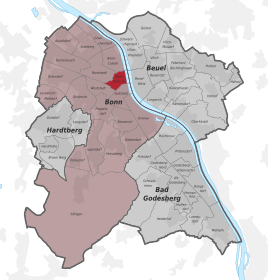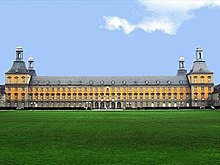Bonn center
|
Bonn center
Federal city of Bonn
Coordinates: 50 ° 44 ′ 6 ″ N , 7 ° 5 ′ 57 ″ E
|
|
|---|---|
| Height : | 60 m above sea level NHN |
| Residents : | 5493 (December 31, 2018) |
| Postcodes : | 53111, 53113 |
| Area code : | 0228 |
|
Location of the Bonn-Zentrum district in the Bonn district
|
|
Bonn-Zentrum is the district of the federal city of Bonn in the city district of Bonn , which includes the Bonn city center . Located near the Rhine , it is the location of many sights and social, cultural and shopping centers in the city.
Location and division of space
Bonn-Zentrum is bordered by the Rhine in the east, and Beuel-Mitte is connected to the Kennedy Bridge on the other side of the river. In the north it borders on the Wachsbleiche street on Bonn-Castell , in the north-west behind the town hall on the north city and in the south with railroad tracks and the Quantius street on West city and south city . The area covers 85 hectares. The district roughly corresponds to the statistical districts center-Münsterviertel and center-Rheinviertel .
The majority of the district forms the actual city center, the pedestrian zone established in 1967 . Its central axis runs from Bertha-von-Suttner-Platz in the north over the market square , Remigiusplatz (flower market) and Münsterplatz to the station forecourt . To the west of it are the Friedensplatz , Bottlerplatz and Mülheimer Platz, to the east the Kaiserplatz . The Friedens- and Marktplatz are connected to the Sternstrasse , and there are also a number of other streets. The highest point in Bonn city center is 61.69 m above sea level. NHN in Acherstrasse near Remigiusplatz; at the main train station and at Kaiserplatz it drops down to 56 m .
A one-way street ring called the City-Ring runs around the pedestrian zone . Bonn-Zentrum also includes the area around Stiftsplatz in the north, the former Rhine district on the riverbank and a triangle between the old cemetery and the railway tracks , which is primarily built with larger office buildings.
history
In Franconian times and finally in the 9th and 10th centuries, a spiritual center developed in the area of the Bonn Minster, the Villa Basilica , and a market settlement in the area of today's market. The arrival of the electors and the founding period caused greater growth spurts. During the Second World War there was massive damage and the destruction of all buildings on the banks of the Rhine in the former Rheinviertel. This quarter was rebuilt after the war without taking into account the old urban structure, and today no longer gives any indication that one of the oldest districts of Bonn was located here. The part of the center around Markt and Münster has been spared complete destruction, so that the relatively few war gaps in the post-war period were built on with modern buildings, most of which, however, resemble the old buildings. As a result, the historically shaped cityscape in this part of the center was preserved.
population
The Bonn center has 5000 inhabitants, about 1.6% of the total population of Bonn. Since 1990 the population has decreased by almost 19%. The average age is 39 years. 40% are Catholic, 21% Protestant and 26% immigrants. There are around 3200 apartments available, especially the upper floors above shops are often empty.
Buildings
At the southern end of the city center is the Electoral Palace , today the seat of the Rheinische Friedrich-Wilhelms-Universität . With its four corner towers, it is one of the most striking buildings in the cityscape and its great length determines the course of the street in the area. The palace includes the court garden and the academic art museum .
The tallest building, on the other hand, is the 81.4 m high Bonn Minster on Münsterplatz. Other places of worship are the Remigius Church in the Brüdergasse (formerly the Brothers Church), in which the basin in which Beethoven was baptized is located, the collegiate church, the Kreuzkirche on Kaiserplatz, the castle chapel and the Namen-Jesu-Kirche in Bonngasse . Collegium Albertinum and Collegium Leoninum are worth seeing Konviktbauten . On the edge of the northern part of the city is the old cemetery with numerous historically significant graves.
Secular sights are the old town hall on the market square, the post office on Münsterplatz, the old town house and the many Wilhelminian style houses . Not necessarily known as beautiful, but the modern townhouse is also striking . The Bonn Central Station originates from 1883. Remains of the old Bonner fortifications can be found on Sterntor (Vivatsgasse) and at the Old Customs (Rhine).
Culture
The Bonn Opera is located south of the Kennedy Bridge and the Beethoven Hall to the north . The house in which he was born , the Beethoven House in Bonngasse, and a statue on Münsterplatz are also reminiscent of the great composer .
Of the originally numerous cinemas in the city center, only Stern and Woki (formerly Universum) have remained since the Metropol was closed in 2005.
There are numerous restaurants and pubs in Bonn's city center, as well as a few smaller clubs.
economy
The largest shops in the city center are operated by the department stores Karstadt , Kaufhof and the electronics store Media Markt . There are also a large number of smaller retail stores and restaurants.
See also
Web links
Individual evidence
- ↑ Population in Bonn by districts (according to the main statute) on December 31 , 2018 , Federal City of Bonn - Statistics Office, February 2019
- ↑ a b “City dwellers don't give a damn about the quiet life in the village”. In: General-Anzeiger Bonn. 116th year, 11./12. November 2006, page 10.
- ↑ Perfect: Bonn's Wenzelgasse will be rebuilt from July. In: General-Anzeiger (Bonn). April 17, 2002, accessed April 4, 2016 .
- ↑ Bronze plaque in Acherstrasse , Wikimedia Commons
- ↑ Acherstraße: bronze plaques are let in , press release of the city of Bonn, January 11, 2008








